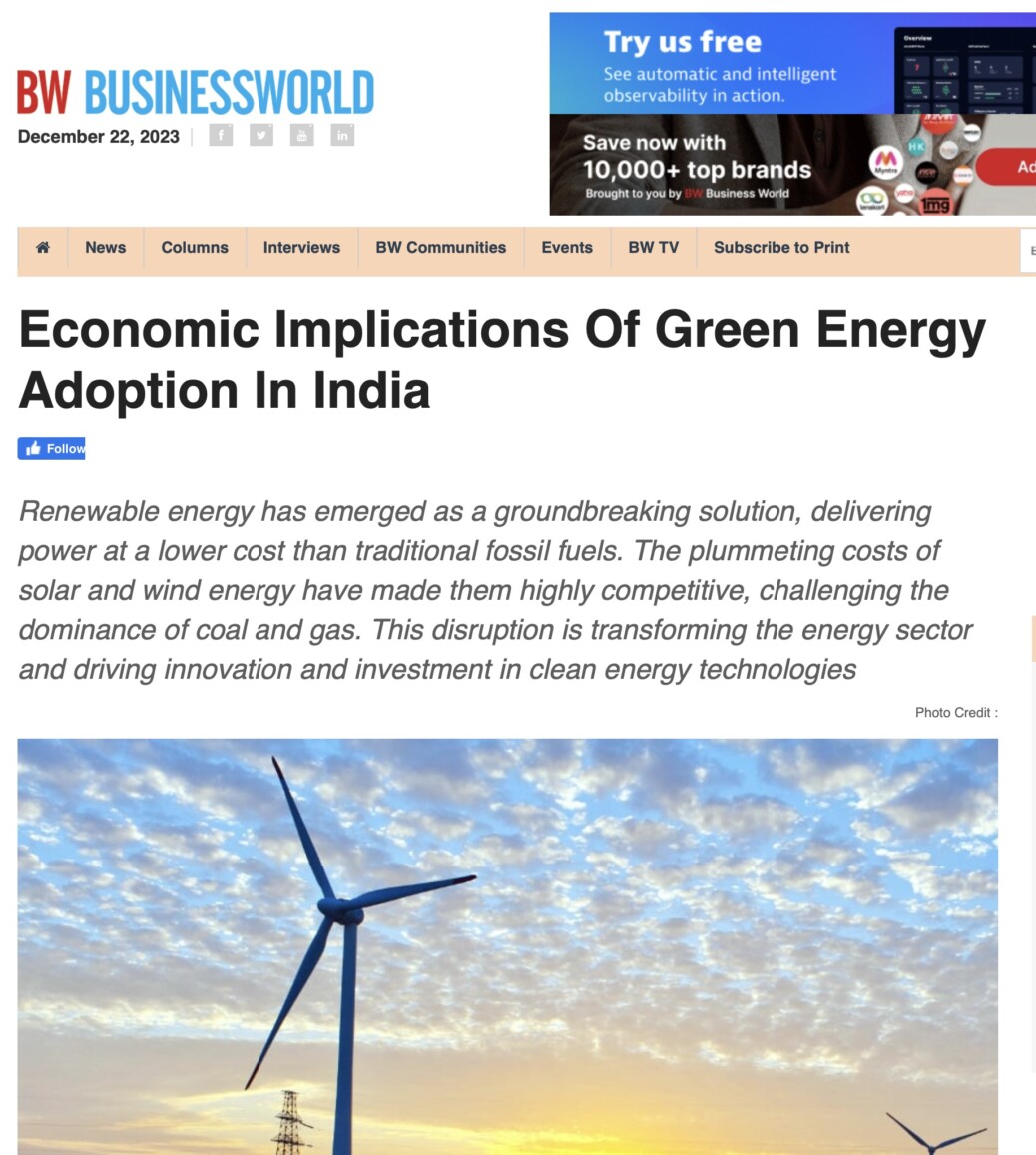By Amit Kapoor and Suryansh Chalamalasetty
India’s energy mix has traditionally been dominated by coal. Thermal energy is generated by burning fossil fuels like coal, natural gas, and oil, which releases heat and produces steam that operates turbines to generate electricity. In contrast, green energy—or renewable energy—refers to power derived from natural sources that are constantly replenished, such as solar, wind, and hydroelectric power. Thermal energy has been the backbone of India’s electricity generation, but it has come with a great deal of environmental pollution and resource depletion and has contributed significantly to the country’s greenhouse gas emissions. On the other hand, green energy comes with a promise of sustainability and reduced environmental impact. There has been a noticeable shift towards renewable energy (RE) in recent years, particularly in solar and wind energy. As of 2023, India has made commendable progress in increasing its installed capacity of renewable energy.
Thermal power plants are associated with negative externalities such as air pollution, which can cause respiratory diseases and environmental degradation. They also emit significant radiation, primarily in the form of thermal pollution, which can harm aquatic ecosystems. Moreover, the extraction and burning of fossil fuels result in carbon emissions that contribute to global warming. Further, the depletion of fossil fuels leads to increased costs as extraction becomes more difficult, and it can create energy security issues. This scarcity can negatively affect both the economy by increasing energy prices and society by reducing the availability of affordable energy.
The role of clean energy in decarbonizing the Indian economy cannot be overstated. The electricity sector, being one of the largest emitters of CO2, has seen asignificant reduction in emissions due to the increased adoption of renewable energy. This transition is crucial for mitigating climate change and improving air quality and public health as well. Introducing Renewable Purchase Obligations (RPOs) has been a pivotal policy tool in this transition. RPOs mandate that a certain percentage of a state’s electricity must be generated from renewable sources, pushing utilities to invest in green energy. This policy, along with favourable tariff policies and incentives, has resulted in a significant increase in the generation percentage of renewable energy. Shifting from a coal-dominated energy mixto a more diverse one with a significant share of renewable energy enhances energy security. This is instrumental in reducing India’s dependence on coal imports, saving foreign exchange and contributing to a more balanced trade. The green transition opens avenues for investments in renewable energy infrastructure, boosting the economy. The renewable energy sector, particularly solar and wind, also has the potential to create numerous jobs, from manufacturing to installation and maintenance.
India’s economic potential with natural resources is vast. Green energy can attract investment, create jobs, foster technological development, and reduce energy import bills. For instance, India has a solar power potential of 750 GW and has crossed 40 GW in installed solar power capacity. While also having around 38 GW of installed capacity, India is among the top wind power-producing countries. Hydroelectric power contributes about 45 GW, with significant potential in the Himalayan and northeastern regions. Investments in renewable energy have been increasing, with substantial expenditures aimed at infrastructure, research, and subsidies to promote green energy adoption. India plans to reach 500 GW of renewable energy capacity by 2030, necessitating substantial financial input.
Adopting renewable energy directly contributes to several of the United Nations Sustainable Development Goals (SDGs), including affordable and clean energy, climate action, good health and well-being, and decent work and economic growth. By transitioning to renewable energy, India is making strides towards creating a more sustainable and equitable society. Moreover, the green energy transition in India has attracted substantial foreign direct investment (FDI), contributing to the country’s economic growth. These investments have indirect benefits that reach the grassroots levels, creating job opportunities and facilitating skill development. The availability of primary resources such as healthcare, clean water, and improved school infrastructure has also seen a positive impact, laying the foundation for the region’s future development.
Renewable energy has emerged as a groundbreaking solution, delivering power at a lower cost than traditional fossil fuels. The plummeting costs of solar and wind energy have made them highly competitive, challenging the dominance of coal and gas. This disruption is transforming the energy sector and driving innovation and investment in clean energy technologies. India has also recognized the importance of developing a robust manufacturing value chain for solarand wind energy. The country is investing in the domestic production of solar panels and wind turbines, reducing dependence on imports and creating a self-reliant energy ecosystem. This strategy not only supports the green energy transition but also boosts the manufacturing sector, contributing to economic growth and job creation. India also has vast potential for offshore wind energy. Exploring this resource can significantly increase the country’s renewable energy capacity and contribute to energy security. The government has started taking steps in this direction, but more focused efforts are required to realize the fullpotential of offshore wind energy.
Several strategies need to be adopted further to improve the penetration of renewable energy in India. These include enforcing stringent Renewable Purchase Obligations, promoting energy storage to address the intermittency of renewable energy, mandating industrial decarbonization, and ensuring the financial stability of distribution companies. These measures will create a conducive environment for the growth of renewable energy and accelerate the green energy transition. The intermittent nature of renewable energy poses a challenge to grid stability and reliability. India needs to invest in dynamic, at-scale energy storage solutions to address this issue. Innovations in battery technology, pumped hydro storage, and other energy storage methods are crucial for ensuring a steady supply of renewable energy and facilitating the integration of RE into the grid.
The green energy transition in India is a monumental task, requiring coordinated efforts from the government, industry, and society. However, the potentialrewards are immense, offering a pathway to a sustainable, resilient, and prosperous future. By embracing renewable energy, investing in technology and infrastructure, and fostering innovation, India can not only mitigate the impacts of climate change but also secure its position as a global leader in sustainable development. The journey is challenging, but the destination is worth every effort.
(Amit Kapoor is chair, Institute for Competitiveness and lecturer, Stanford University. Suryansh Chalamalasetty is researcher at large with Institute for Competitiveness).
The article was published with Business World on December 20,2023.























